A Viewer’s Guide to RobiHachi: Episode 11

~
***SPOILER ALERT***
This episode guide may include plot and/or character reveals.
~
Japanese Title: 聞いて極楽、イセカンダル
English Title: Common Fame is a Common Isekander
Characters: Robby Yarge, Hatchi Kita, Ikku/JPS-19, Yang, Allo, Gras, Priestess Spacia*, Middle-Aged Woman*, Mr. Kodai, Ms. Morisugi, Lunar Guard Captain
*Indicates the first appearance in the series.
Summary: At long last, Robby, Hatchi, and Ikku reach Isekander, a planet surrounded by dazzling rings of illuminated advertisements. They visit Okage Street first, crowded with souvenir shops, restaurants, and night clubs, and afterward, head for Oharaitown to find lodging. That evening, Robby undergoes purification rituals, and Hatchi watches videos of their trip.
Early the next morning, Robby, Hatchi, and Ikku follow the trail to Isekander Shrine. After they view the gigantic Akafu Crystal and receive a blessing from the shrine maiden Spacia, Robby buys a small crystal and storage pouch. Meanwhile, Hatchi is horrified to discover the pouches are literally cut from living Isekangaroos. People in the crowd spontaneously proclaim their miraculous good fortune, which drives an insatiable Robby to break a larger chunk from the main Akafu Crystal. He is shocked to learn the “crystal” is made of polycarbonate.
Seeking answers to this mystery, Robby, Hatchi, and Ikku find a hidden hallway lined with rooms. They recognize the advertising agents from Pluto, Mr. Kodai and Ms. Morisugi. In another room, staff analyze the Okage Street and Oharai Town revenue streams. An employee launches an Akafu Jack drone to stimulate sales. Spacia and the people claiming miracles are part-time workers. The crystals are hand-shaped from polymer resin by middle-aged women. Robby, Hatchi, and Ikku conclude Isekander is a complete sham, nothing more than a commercial enterprise by the colossal advertising agency Dontsū, Inc.
Robby is heartbroken until one of the women explains the original crystal is still worshipped by locals. Following her directions, Robby finds the genuine Akafu Crystal in some isolated woods behind the tourist area. He stumbles over a small, plain stone, which he pockets as a souvenir of the eventful journey.
Having discovered Robby’s debt has been paid, an angry Yang arrives at Isekander, where he decides to grab the biggest souvenir of all. He uses the ship’s grappling hook to lift the giant Akafu Crystal from its setting, exposing the advertising agency building underneath. Angry tourists begin rioting.
As five large spaceships bear down on Robby and company, Hatchi confesses to being Prince of the Moon.
Notes
See “Getting Started” for background information on the anime, which is based on an Edo Period fiction series called Tōkaidōchū Hizakurige.
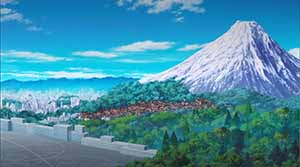 Religious pilgrimages to the Ise Grand Shrine were first promoted during the Sengoku (Warring States) Period. By the Edo Period, these pilgrimages were as much recreational getaways as spiritual journeys. See also episode 1 notes.
Religious pilgrimages to the Ise Grand Shrine were first promoted during the Sengoku (Warring States) Period. By the Edo Period, these pilgrimages were as much recreational getaways as spiritual journeys. See also episode 1 notes.
 Okage Street on planet Isekander is a parody of Okage Yokocho, an Edo- and Meiji-style re-creation of the road leading to the Ise Grand Shrine.
Okage Street on planet Isekander is a parody of Okage Yokocho, an Edo- and Meiji-style re-creation of the road leading to the Ise Grand Shrine.
 Okage, which literally means “blessing”, refers to special mass pilgrimages to Ise called okage mairi that were held roughly every 60 years. During okage mairi years, the Ise Grand Shrine recorded receiving 228,000 visitors per month.
Okage, which literally means “blessing”, refers to special mass pilgrimages to Ise called okage mairi that were held roughly every 60 years. During okage mairi years, the Ise Grand Shrine recorded receiving 228,000 visitors per month.
 The conventions for visiting Isekander Shrine are a parody of the purification rituals people undergo prior to visiting Ise Grand Shrine.
The conventions for visiting Isekander Shrine are a parody of the purification rituals people undergo prior to visiting Ise Grand Shrine.

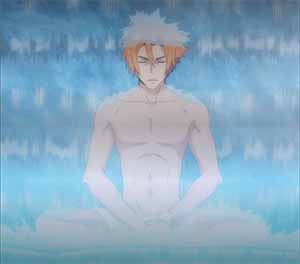 While not a required ritual for Ise Grand Shrine, a particularly rigorous purification ritual called misogi takigyō involves standing or sitting at the base of a waterfall.
While not a required ritual for Ise Grand Shrine, a particularly rigorous purification ritual called misogi takigyō involves standing or sitting at the base of a waterfall.
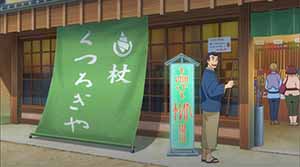 The Kutsurogiya store selling Isekandar canes is a parody of a famous incense shop of the same name. Isekander canes are parodies of staffs called enju tsue (“longevity staffs”) that are blessed at Ise Grand Shrine and given to visitors 80 years old and up.
The Kutsurogiya store selling Isekandar canes is a parody of a famous incense shop of the same name. Isekander canes are parodies of staffs called enju tsue (“longevity staffs”) that are blessed at Ise Grand Shrine and given to visitors 80 years old and up.

 The drawing of fortunes, called omikuji, is a common practice at shrines and of course, an important source of revenue. There are five types of fortunes: bad, small, average, good, and great.
The drawing of fortunes, called omikuji, is a common practice at shrines and of course, an important source of revenue. There are five types of fortunes: bad, small, average, good, and great.
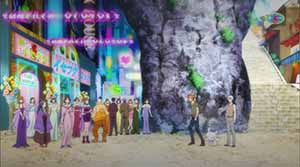 Oharai Town is a parody (or not) of Oharaimachi, a tourist area near the Ise Grand Shrine filled with souvenir stands, craft shops, and restaurants. As Ikku sarcastically points out, oharai literally means “purification.”
Oharai Town is a parody (or not) of Oharaimachi, a tourist area near the Ise Grand Shrine filled with souvenir stands, craft shops, and restaurants. As Ikku sarcastically points out, oharai literally means “purification.”
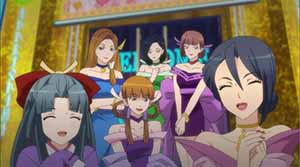 The Isefuku hostess clubs offer cloistered services, aka private rooms and rituals to drive away evil spirits. This joke involves a pun on the word okōmori, which can mean either 1) a ritual involving incense or 2) a session of scandalous behavior.
The Isefuku hostess clubs offer cloistered services, aka private rooms and rituals to drive away evil spirits. This joke involves a pun on the word okōmori, which can mean either 1) a ritual involving incense or 2) a session of scandalous behavior.
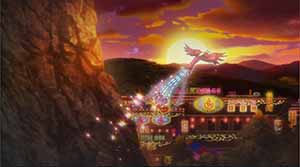 The sacred Akafu Jacks are parodies of the phoenix, the appearance of which is considered particularly auspicious. The character design resembles the Phoenix created by legendary manga artist Tezuka Osamu.
The sacred Akafu Jacks are parodies of the phoenix, the appearance of which is considered particularly auspicious. The character design resembles the Phoenix created by legendary manga artist Tezuka Osamu.
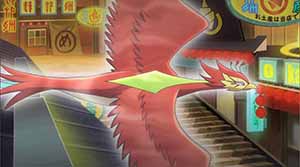 The name Akafu Jack (akafu jakku) can be translated into “advertising catchphrase ‘lucky red’”.
The name Akafu Jack (akafu jakku) can be translated into “advertising catchphrase ‘lucky red’”.
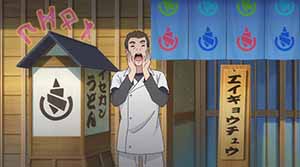 The Isekander logo posted everywhere is an Akafu Crystal.
The Isekander logo posted everywhere is an Akafu Crystal.
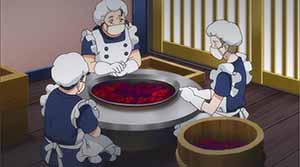 Akafu Crystals are a parody of an Ise souvenir specialty food called akafuku mochi, consisting of rice paste encased in sweetened red bean paste.
Akafu Crystals are a parody of an Ise souvenir specialty food called akafuku mochi, consisting of rice paste encased in sweetened red bean paste.
 The multi-crested shape of akafuku mochi represents ripples in the sacred Isuzu River, which flows next to the Ise Grand Shrine.
The multi-crested shape of akafuku mochi represents ripples in the sacred Isuzu River, which flows next to the Ise Grand Shrine.
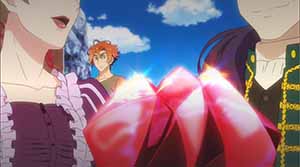 In the brief scene of a couple celebrating their purchase of an extra-large Akafu Crystal, the uncredited voice actors sound like Tomokazu Sugita (Yang) and Rei Kugimiya (Spacia). Sugita, Kugimiya, Kazuya Nakai (Robby), and Daisuke Sakaguchi (Ikku) worked together for many years on the Gintama anime, which was directed by Shinji Takamatsu.
In the brief scene of a couple celebrating their purchase of an extra-large Akafu Crystal, the uncredited voice actors sound like Tomokazu Sugita (Yang) and Rei Kugimiya (Spacia). Sugita, Kugimiya, Kazuya Nakai (Robby), and Daisuke Sakaguchi (Ikku) worked together for many years on the Gintama anime, which was directed by Shinji Takamatsu.
 The straw rope and paper streamers draped over the Akafu Crystal are parodies of Shinto talismans respectively called shimenawa and shide, which are used to mark a sacred object or space.
The straw rope and paper streamers draped over the Akafu Crystal are parodies of Shinto talismans respectively called shimenawa and shide, which are used to mark a sacred object or space.
 Ikku utters, “Money is the key that opens all doors.” This proverb is also parodied in episode 5.
Ikku utters, “Money is the key that opens all doors.” This proverb is also parodied in episode 5.
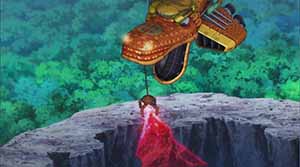
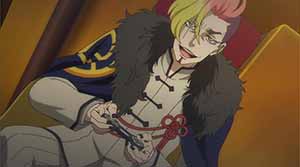 The grappling hook, game controls, and Yang’s nickname “Crane Game Yang” are parodies of an arcade game that involves grabbing prizes using a joystick to maneuver a pronged claw. In episode 2, Robby played a version of this game during his night out with Glamorous Girl.
The grappling hook, game controls, and Yang’s nickname “Crane Game Yang” are parodies of an arcade game that involves grabbing prizes using a joystick to maneuver a pronged claw. In episode 2, Robby played a version of this game during his night out with Glamorous Girl.
 The priestess café Robby wants to visit is a parody of a maid café, which is a coffee shop staffed by young, pretty women dressed in maid costumes. These cosplay cafes are not to be confused with a mikosan café that has real shrine maidens and sometimes a shrine.
The priestess café Robby wants to visit is a parody of a maid café, which is a coffee shop staffed by young, pretty women dressed in maid costumes. These cosplay cafes are not to be confused with a mikosan café that has real shrine maidens and sometimes a shrine.
 In the next-episode preview, a sidebar comment notes the name of Yang’s ship is “Golden Dolphin Warship.”
In the next-episode preview, a sidebar comment notes the name of Yang’s ship is “Golden Dolphin Warship.”
~
anime blog Hizakurige Japan Jippensha Ikku RobiHachi Tōkaidō viewers guide